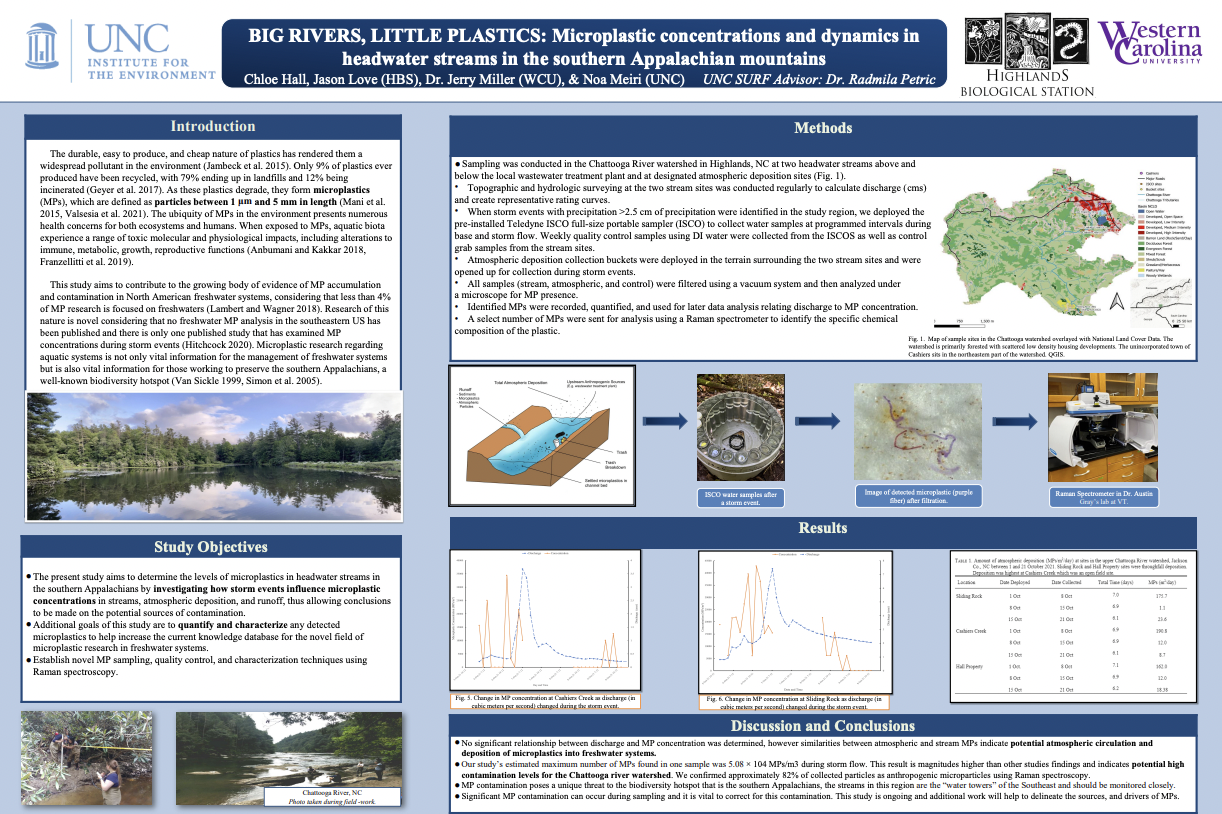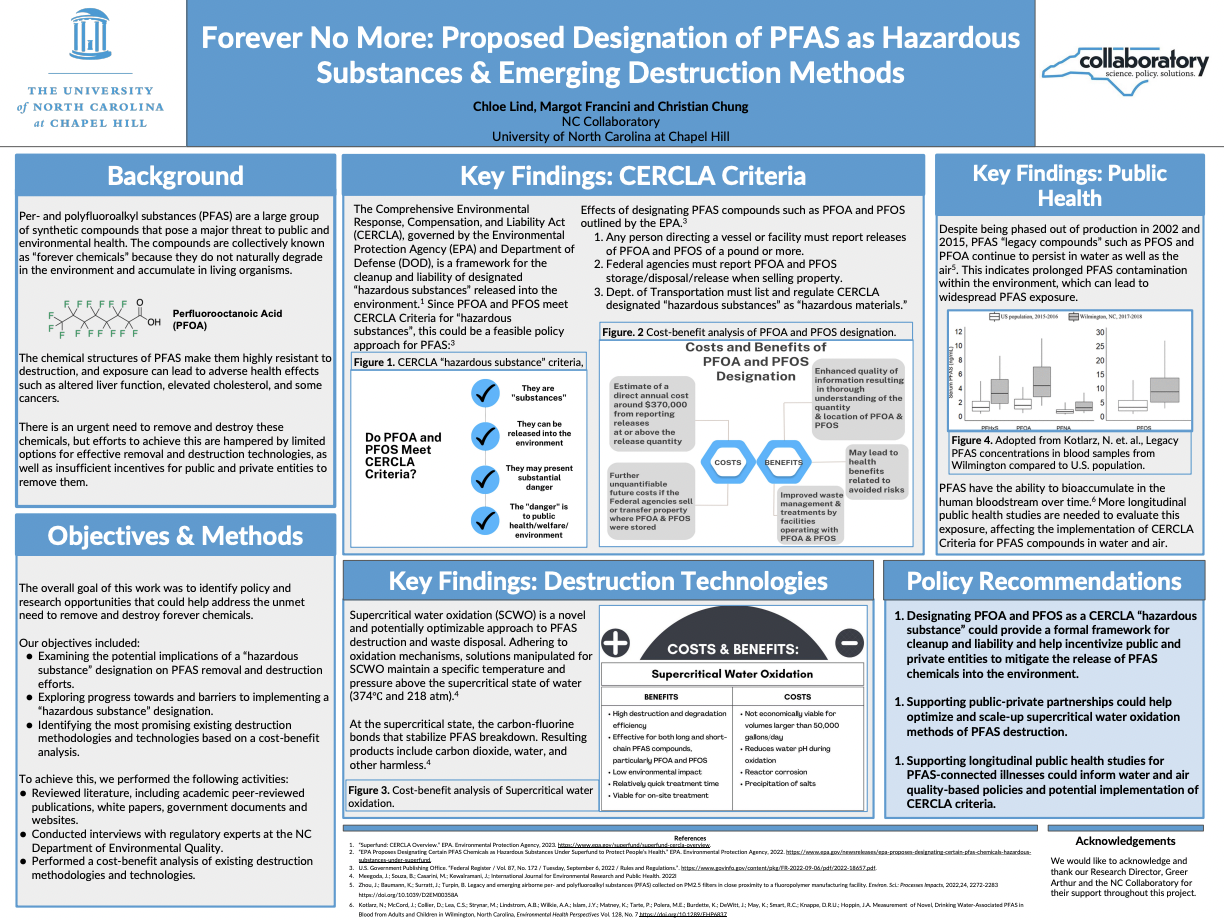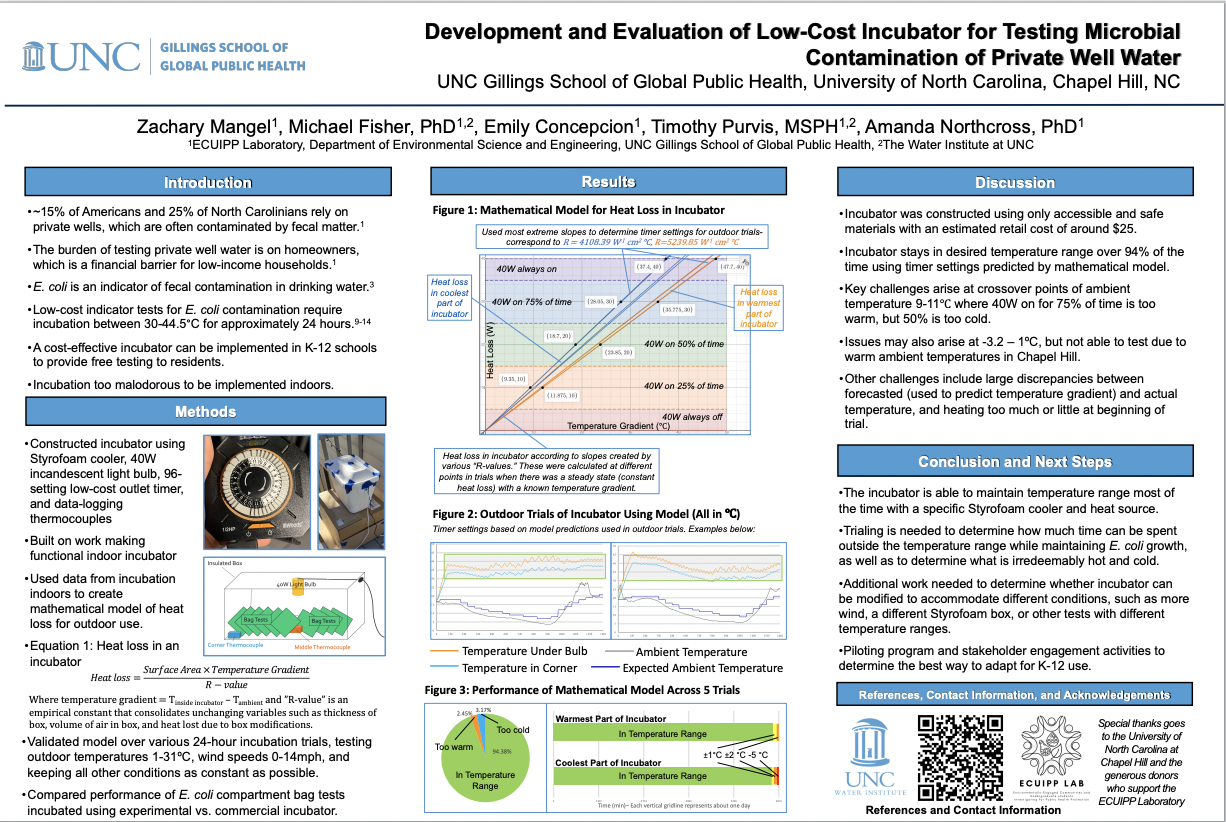For the first time, Sustainable Carolina awarded students prizes for excellent sustainability research at the Celebration of Undergraduate Research. UNC Institute for the Environment Associate Director Susan Cohen and Ileana Fenwick, a UNC Earth, Marine and Environmental Sciences doctoral student, judged 17 research posters at the annual event, hosted by the Office for Undergraduate Research.
“Each project was a testament to the interdisciplinary and impactful nature of UNC-Chapel Hill research,” says Fenwick. “It was especially powerful to see students at the undergraduate level get that experience as well. What excited me the most was hearing how each of the students grew in their research and their intentions to continue research in their time at Carolina and beyond.”
Sustainable Carolina worked with the Office for Undergraduate Research Associate Director Bob Pleasants to offer the awards. This partnership ties in with one of Sustainable Carolina’s strategic framework goals: nurturing educational efforts. To achieve this goal, the team supports experiences that empower students to think about sustainability locally and globally.
Since Chancellor Guskiewicz created the Sustainability Council in 2020, Sustainable Carolina has broadened its sustainability efforts. In addition to tracking greenhouse gas emissions, water use and waste to landfill, the team also encourages innovative sustainability research with impact.
“The students’ work was overwhelmingly engaging and thoughtful, and addressed sustainability from so many different angles – the diversity was fantastic,” says Cohen. “The posters were of such a high caliber, it was hard to choose a winner. I know this sounds cheesy, but they are all winners!”
When registering their posters, students checked a box to opt-in to the sustainability awards. Cohen and Fenwick judged the posters based on a five-category rubric: applicability to sustainability, abstract, poster appearance, presentation and community impact. The top three posters received cash prizes: $300 for first, $150 for second and $50 for third.
The winners come from UNC Institute for the Environment’s Highlands Field Site, the NC Collaboratory, Department of Public Policy and the Department of Environmental Sciences and Engineering in UNC Gillings School of Global Public Health.
First Prize: BIG RIVERS, LITTLE PLASTICS: Microplastic Concentrations and Dynamics in Headwater Streams in the Southern Appalachian Mountains by Chloe Hall
Department: UNC Institute for the Environment
Faculty Research Mentor: Radmila Petric
There is a growing concern regarding the ubiquity of microplastics (<5 mm) in our environment and atmosphere potentially threatening the health of wildlife and humans; however, little research has been done to explore how microplastics behave in freshwater systems. In this study, we measured microplastic concentrations and loads at baseflow and during a storm event in the headwaters of the Chattooga River over a two-month period. We also measured the atmospheric deposition rate of microplastics at three locations in the watershed. At two sites along the Chattooga River, we collected water samples throughout a storm event to assess how microplastic concentrations varied with discharge. No significant relationship between river discharge and MP concentration was identified, however, similarities were identified between atmospheric deposition and stream particles indicating potential atmospheric circulation and deposition of MPs into freshwater systems. These data also indicate a potentially high concentration of microplastics polluting the Chattooga Watershed. 82% of the MPs collected in this study were confirmed as anthropogenic microparticles via Raman spectroscopy. Although this is a preliminary study, our results are important to further the current understanding of microplastic contamination in freshwater systems and can hopefully be used to better inform future microplastic studies and management efforts.

Second Prize: Forever No More: Proposed Designation of PFAS as Hazardous Substances & Emerging Destruction Methods by Christian Chung, Chloe Lind, Margot Francini
Department: NC Collaboratory, Department of Public Policy
Faculty Research Mentor: Greer Arthur
Per- and polyfluoroalkyl substances (PFAS) are a large class of synthetic chemical compounds that have been manufactured since the 1940s. Due to their long-term stability, imparted by their carbon-fluorine bonds, PFAS have a multitude of applications in manufacturing and consumer products. However, these same properties make them very difficult to destroy and have led to increasing concerns about their impact on environmental and public health. For example, PFAS can persist within drinking water for long periods of time, and when ingested, can bioaccumulate in the bloodstream, with links to adverse health effects such as altered liver function, elevated cholesterol, and some cancers. Although limiting production and increasing cleanup and destruction of PFAS are critical for protecting environmental and public health, no statutory regime currently accounts for PFAS exposure over the course of a person’s lifetime, and there is limited access to effective destruction technologies. To identify potential research and policy needs that could help reduce long-term exposure to PFAS and improve the feasibility of PFAS destruction, we performed literature reviews and interviews with regulators. Through these efforts, we discovered that the U.S. Environmental Protection Agency (EPA) has enacted health advisory and maximum contaminant levels for select PFAS compounds, but PFAS are not currently designated “hazardous substances.” However, existing policy structures may be well suited to PFAS, such as the Comprehensive Environmental Response, Compensation, and Liability Act (CERCLA), which deters individuals and manufacturers from releasing more “hazardous substances” into the environment than current laws permit. If PFAS compounds such as PFOA and PFOS were designated as “hazardous substances,” polluters would be held liable for contamination, which could help mitigate continued manufacturing and environmental release while promoting greater cleanup and destruction efforts. In addition to a CERCLA-backed designation, research and development related to PFAS destruction methods should be supported, with a view to developing cost-effective, eco-friendly and widely accessible destruction technologies. Supercritical water oxidation is an existing method that has been proven to effectively degrade PFAS compounds, but further support for private-public partnerships could facilitate rapid upscaling of this approach for the benefit of both public welfare and private revenue. Finally, additional support for longitudinal public health research is critical, because there are still many unknowns related to the long-term effects of PFAS exposure that could have important implications for both PFAS destruction research and CERCLA designations.

Third Prize: Development and Evaluation of Low-Cost Incubator for Testing Microbial Contamination of Private Well Water by Zachary Mangel
Department: Environmental Science and Engineering
Faculty Research Mentor: Amanda Northcross
This project was carried out with the goal of creating an accessible low-cost incubator that can be implemented outdoors in low-income K-12 schools and maintain a temperature of 30-44.5°C. Incubation in this range is necessary for 18-24 hours to test water samples for fecal indicator bacteria, Escherichia coli. A need for this project arises due to the elevated costs of commercial incubators and the financial burden of testing private wells on low-income users. In this study, a 40W incandescent light bulb was used to heat a Styrofoam cooler containing data-logging thermocouples and ten plastic bags with 100 mL of water (which mimicked the thermal properties of ten E. coli compartment bag tests). Using a thermostat under constant ambient conditions, a mathematical model was created to predict the amount of heat loss from the incubator given any temperature gradient (difference in temperature inside and outside the incubator). A low-cost outlet timer was then used with settings predicted by the model to impose a relatively steady-state amount of heat in the incubator for a 24-hr period. The incubator, using the timer and under the prediction of the model, was able to maintain the desired temperature range over 94% of the time, as well as produced similar results when tested against a commercial incubator with compartment bag tests. These results indicate that simultaneous incubation of up to ten low-cost compartment bag tests is achievable with an estimated build cost of just $25.

